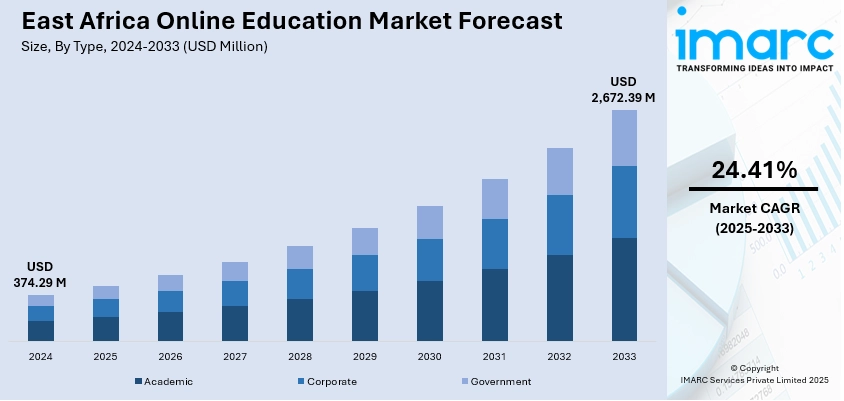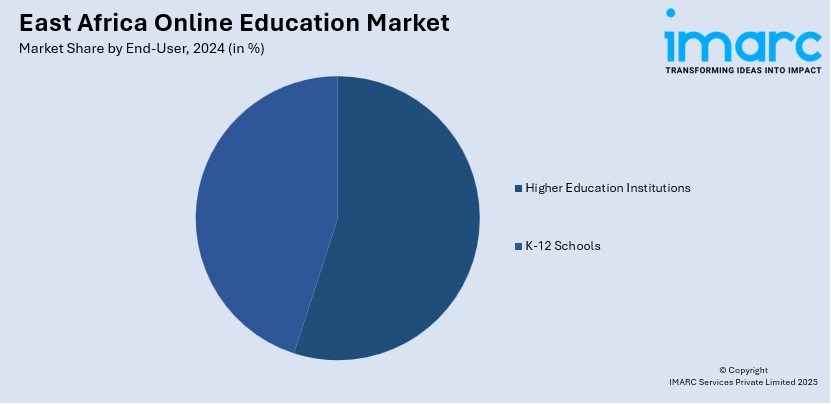
East Africa Online Education Market Size, Share, Trends and Forecast by Type, Provider, Technology, End-User, and Country, 2025-2033
East Africa Online Education Market Overview:
The East Africa online education market size reached USD 374.29 Million in 2024. Looking forward, the market is expected to reach USD 2,672.39 Million by 2033, exhibiting a growth rate (CAGR) of 24.41% during 2025-2033. The market is experiencing significant growth due to improved internet access, growing demand for affordable education, and the shift toward digital learning. Key players are offering diverse online courses in fields such as technology, business, and vocational skills which is also promoting online education. With mobile learning platforms on the rise, the East Africa online education market share is steadily increasing, reflecting the region's evolving educational landscape.
|
Report Attribute
|
Key Statistics
|
|---|---|
|
Base Year
|
2024
|
|
Forecast Years
|
2025-2033
|
|
Historical Years
|
2019-2024
|
| Market Size in 2024 | USD 374.29 Million |
| Market Forecast in 2033 | USD 2,672.39 Million |
| Market Growth Rate 2025-2033 | 24.41% |
East Africa Online Education Market Trends:
Government Support
Governments in East Africa are increasingly viewing the role of digital education as crucial and are proactively promoting development in the sector of online learning. Efforts at promoting digital literacy, enhancing internet infrastructure, and expanding access to technology are taking shape. Nations such as Kenya, Uganda, and Rwanda have been rolling out policies to support online education and the acquisition of digital skills setting the stage for market expansion. For instance, in March 2025, Huawei, UNESCO, and partners from the Kenyan government announced the successful completion of Phase II of the Kenya DigiSchool Connectivity Project, which has connected 21 schools six of which serve deaf children to high-speed internet. This initiative aims to improve online learning opportunities, facilitate remote support, and enhance educational outcomes when paired with effective technological solutions. Additionally, infrastructure investments such as the expansion of internet connectivity in rural and underserved areas are making online education more accessible. In some countries, governments have partnered with private sector players to introduce e-learning platforms offering affordable online courses to a wider population. This government support is not only improving access to education but also contributing to the East Africa online education market growth, meeting the increasing demand for flexible, affordable learning solutions in the region.

To get more information on this market, Request Sample
Growth in EdTech Platforms
The rise of EdTech platforms in East Africa is transforming the education landscape, offering a broad range of online courses from vocational training to university-level degrees. Local and international EdTech companies are collaborating with educational institutions to expand their reach and improve access to quality education. Partnerships between local universities and global EdTech providers have led to the creation of specialized online degree programs and certifications in high-demand fields such as technology, business, and healthcare. These collaborations allow learners to earn globally recognized qualifications without leaving the region. For instance, in October 2024, Kenyan edtech startup Eneza Education and Pakistan’s Knowledge Platform announced their merger to create a pioneering venture based in Singapore, aiming to enhance access to quality education across Africa and Asia. The partnership combines SMS-based learning and gamified digital education, targeting over a million learners in emerging markets. Furthermore, partnerships with mobile network operators have made online education more accessible by enabling affordable data plans for students. As the demand for flexible, accessible education grows, these strategic partnerships play a crucial role in shaping the future of the East Africa online education market, enhancing both content availability and reach.
East Africa Online Education Market Segmentation:
IMARC Group provides an analysis of the key trends in each segment of the market, along with forecasts at the regional and country levels for 2025-2033. Our report has categorized the market based on type, provider, technology, and end-user.
Type Insights:
- Academic
- Higher Education
- Vocational Training
- K–12 Education
- Corporate
- Large Enterprises
- SMBs
- Government
The report has provided a detailed breakup and analysis of the market based on the type. This includes academic (higher education, vocational training, and K–12 education), corporate (large enterprises and SMBs), and government.
Provider Insights:
- Content
- Services
A detailed breakup and analysis of the market based on the provider have also been provided in the report. This includes content and services.
Technology Insights:
- Mobile E-Learning
- Rapid E-Learning
- Virtual Classroom
- Others
A detailed breakup and analysis of the market based on the technology have also been provided in the report. This includes mobile e-learning, rapid e-learning, virtual classroom, and others.
End-User Insights:

- Higher Education Institutions
- K–12 Schools
A detailed breakup and analysis of the market based on the end-user have also been provided in the report. This includes higher education institutions and k–12 schools.
Country Insights:
- Ethiopia
- Kenya
- Tanzania
- Uganda
- Sudan
- Rwanda
- Others
The report has also provided a comprehensive analysis of all the major regional markets, which include Ethiopia, Kenya, Tanzania, Uganda, Sudan, Rwanda, and others.
Competitive Landscape:
The market research report has also provided a comprehensive analysis of the competitive landscape. Competitive analysis such as market structure, key player positioning, top winning strategies, competitive dashboard, and company evaluation quadrant has been covered in the report. Also, detailed profiles of all major companies have been provided.
East Africa Online Education Market News:
- In June 2025, the Ethiopian Horticulture Producer Exporters Association, in partnership with TradeMark Africa, launched the 'Horti-Campus' E-learning platform to enhance the horticulture sector. This platform offers flexible training on Good Agricultural Practices, environmental sustainability, and more, aiming to build a skilled workforce and improve productivity across Ethiopia's horticulture industry.
- In April 2025, JP.ik and UNESCO IITE launched a project in Kenya to enhance inclusive and sustainable education. The initiative equips teachers with digital tools and training, focusing on STEM and vocational education. Online resources will be available, promoting environmental sustainability and digital inclusion while aligning with national education priorities.
- In February 2025, the China-Africa Digital Learning Center was inaugurated at the Open University of Kenya, strengthening educational collaboration between China and Africa. This center aims to develop digital skills and facilitate joint online programs, supporting Kenya's transition to a knowledge-based economy while promoting cultural exchange between China and African nations.
East Africa Online Education Market Report Coverage:
| Report Features | Details |
|---|---|
| Base Year of the Analysis | 2024 |
| Historical Period | 2019-2024 |
| Forecast Period | 2025-2033 |
| Units | Million USD |
| Scope of the Report |
Exploration of Historical Trends and Market Outlook, Industry Catalysts and Challenges, Segment-Wise Historical and Future Market Assessment:
|
| Types Covered |
|
| Providers Covered | Content, Services |
| Technologies Covered | Mobile E-Learning, Rapid E-Learning, Virtual Classroom, Others |
| End-Users Covered | Higher Education Institutions, K-12 Schools |
| Countries Covered | Ethiopia, Kenya, Tanzania, Uganda, Sudan, Rwanda, Others |
| Customization Scope | 10% Free Customization |
| Post-Sale Analyst Support | 10-12 Weeks |
| Delivery Format | PDF and Excel through Email (We can also provide the editable version of the report in PPT/Word format on special request) |
Key Questions Answered in This Report:
- How has the East Africa online education market performed so far and how will it perform in the coming years?
- What is the breakup of the East Africa online education market on the basis of type?
- What is the breakup of the East Africa online education market on the basis of provider?
- What is the breakup of the East Africa online education market on the basis of technology?
- What is the breakup of the East Africa online education market on the basis of end user?
- What is the breakup of the East Africa online education market on the basis of country?
- What are the various stages in the value chain of the East Africa online education market?
- What are the key driving factors and challenges in the East Africa online education market?
- What is the structure of the East Africa online education market and who are the key players?
- What is the degree of competition in the East Africa online education market?
Key Benefits for Stakeholders:
- IMARC’s industry report offers a comprehensive quantitative analysis of various market segments, historical and current market trends, market forecasts, and dynamics of the East Africa online education market from 2019-2033.
- The research report provides the latest information on the market drivers, challenges, and opportunities in the East Africa online education market.
- Porter's five forces analysis assist stakeholders in assessing the impact of new entrants, competitive rivalry, supplier power, buyer power, and the threat of substitution. It helps stakeholders to analyze the level of competition within the East Africa online education industry and its attractiveness.
- Competitive landscape allows stakeholders to understand their competitive environment and provides an insight into the current positions of key players in the market.
Need more help?
- Speak to our experienced analysts for insights on the current market scenarios.
- Include additional segments and countries to customize the report as per your requirement.
- Gain an unparalleled competitive advantage in your domain by understanding how to utilize the report and positively impacting your operations and revenue.
- For further assistance, please connect with our analysts.
 Request Customization
Request Customization
 Speak to an Analyst
Speak to an Analyst
 Request Brochure
Request Brochure
 Inquire Before Buying
Inquire Before Buying




.webp)




.webp)












